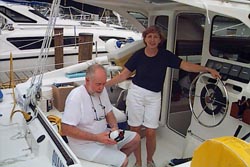 Performance Sailing Makes Annapolis A One-Cat Town
Performance Sailing Makes Annapolis A One-Cat Town Performance Sailing Makes Annapolis A One-Cat Town
Performance Sailing Makes Annapolis A One-Cat Town
You'll See Tony and Sue Smiths' Newest Gemini at the U.S. Sailboat Show
Plus What Else You'll See at the Show
by Christy Grimes
Bob and Trudy Moore, aboard their new home - a Gemini catamaran made by Performance Cruising on Back Creek in Eastport. photo by Christy Grimes
Where Back Creek opens to Chesapeake Bay, a tidy row of floating platforms bob, each under its own shallow canvas tent pitched for shelter. Each September, when the platforms are moored here in preparation for the U.S. Sailboat Show, Back Creek looks like a semi-submerged Methodist camp meeting. Come October, they are towed over to Ego Alley to be set up as temporary docks and walkways between the show boats.
That's when City Dock casts a megawatt glow like the Naval Academy during night practice. The dock is wrapped in chain-link shrouded in tarps while the boat show gnomes tinker through the night, creating an ephemeral tent city.
But this story begins in September, when the platform sections remain perched expectantly at the head of Back Creek. Around a bend, where the marinas leave off and the creek narrows, rests a clutch of white catamarans. One of them belongs to Bob and Trudy Moore, who bought it just five hours ago. They sit in their new dinette, a six pack on the table to celebrate their new purchase - and much more.
Bob and Trudy have just retired. They are celebrating a new life. Celebrating with their friends George and Jess Corazon. Both couples have chartered boats together many times in the Caribbean and other idyllic spots on vacation. Now Bob and Trudy have their own boat to make the most of their permanent vacation.
"Want to trade lives?" cracks a guy on the dock, overhearing Bob's gloating.
"Wanna be 65?" Bob rejoins.
Dreamland 21403 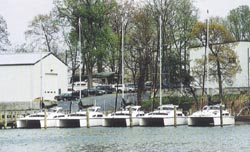
Uphill from the catamarans bobbing peacefully on their moorings is what from down here looks like a six-boat garage. Inside, a row of six identical catamarans peek out through the open doorway.
Closer, the smell of fiberglass resin and epoxy, the scream of grinders and the dust they raise suggest something different. Closer still, you see that many of these boats are missing key parts, like windows, an engine, all their insides. Some are just empty hulls.
That's at one end of the shed. At the other end is a finished, fully equipped boat identical to Bob and Trudy's, except that in place of the happy retirees preparing for a new life, a dusty, sweaty, man is bunched in a corner wielding a power drill. This is Tony Smith, the man who owns the shed - plus all the boats in it.
Smith and his crew toil to put the finishing touches on their entry to the U.S. Sailboat Show, a 36-foot catamaran identical to the one he has just sold to Moore. By mass-producing identical boats, Smith can sell them at a reasonable cost for a boat of this size and caliber: around $125,000.
Customizing is left to the owners. Gemini owners have their own association apart from the company, in which they trade tips and commiserate. To Sue Smith, Tony's wife and business partner, the sailing life tends to level differences and fosters its own community. "They're on a small boat doing the same thing: cooking their meals, tying lines, getting wet, cleaning their boats."
photo by Christy Grimes Molding a Gemini hull, at right below.
The Family of Cats
'Catamaran' is Tamil for 'tie logs,' which probably described fully the
first-known cat ancestor. Today's catamaran is any craft with two hulls
yoked parallel by some sort of cross beam. This could include two hollow
logs with branches tied crosswise or the Smiths' Gemini 105 cruiser with
spacious dinette and teak trim.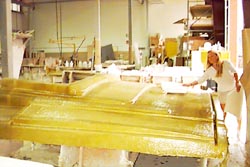
Polynesians developed the basic catamaran from a simple raft to a tough but finely balanced fishing craft able to ride big waves. Cats remained a specialty act or fringe boat in the U.S. for years, their audience restricted to places like California where they appeared in scaled-down hot-dogging versions like the Hobie Cat.
The Moores have never been to California and don't intend to hang drastically off the side of their boat. Nor will they have to. The advantage of catamarans, especially of this size, is the supreme balance granted by the wide, low base. It would take a violent sea to make it turn turtle.
The problem with cats is that, hard as they are to tip, once it happens, they are tough to right. Since the Moores don't plan to cross the ocean or sail into the eye of a hurricane, they aren't worried.
The Moores' new boat - like its 200 or so cousins on the Bay - is one of 40 the Smiths crank out each year, assembly-line style. "Just like Henry Ford," says Sue Smith. Maybe, but slowed way down.
The Smiths have 20 workers in their plant. The five boats - or shells about to be boats - each represent a building stage.
At one end of the shed is a newly cast shell. At the other end is a finished craft getting final touch-ups before being rolled down to the dock, where it meets its buyer. Except this time.
Show Time
The week before the boat show, the boat at the end of the line is the boat show demo, and when it's ready, the Smiths will roll it down to the dock, climb aboard and sail it to the boat show.
For Performance Cruising, the boat show isn't quite the party you'd expect. Once Smith docks his catamaran and the boat show opens, the family will meet and greet a steady stream of would-be owners. "Thirty, thirty-five percent of our orders come from the Annapolis Boat Show, whether it's immediate or down the road somewhere," Sue Smith says. Anyone checking out a six-figure boat is unlikely to buy it on the spot. Rather, there is an incubation period. "What typically happens is, someone will see the boat at the show but not buy for another two years."
Head for the Hills
Seen across Spa Creek from City Dock, Trumpy's boathouse rules the skyline of the Maritime Republic of Eastport, a proud symbol of the Republic's boatbuilding history. But Trumpy is long gone. The boathouse is a shell for the Chart House restaurant.
Annapolis zoned the Eastport peninsula for maritime-related business to protect its boatbuilding heritage. So where are the boatbuilders?
Most of the current industry is 'soft maritime,' or maritime services. Nuts-and- bolts businesses like Performance Cruising are rare and endangered.
"There's Larry Belkov, who does one-offs, boats custom-built or cast singly from a mold. But they're handcrafted and cost a mint," says Mick Blackistone, local sailor and vice president of the National Marine Manufacturer's Association.
"Tony," Blackistone adds, "is the only sailboat manufacturer in the state and the only real production boatbuilder in Annapolis."
What's more, Performance Cruising is the newest.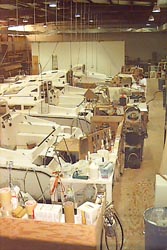
The Smiths, originally from England, moved their operation to Annapolis two years ago, after 14 years in Mayo. "We bought four acres and put up the plant on grounds that 20 years ago were Burt Jabin's original marina. In between, it was called Junk Jungle Alley," says Sue Smith. Here they have erected a 60' x 250' building of "15,000 or 16,000 square feet." In it are offices and a light, airy production plant.
Performance Cruising pays tall for its Eastport address. "Building in Annapolis was dreadful. Since we're the only manufacturing plant in the city, we were concerned to be doing the right thing, but the city put us over the top," Sue Smith remembers.
Adds Blackistone: "The question with a production builder is, 'Do I want to spend the money and have to deal with the city of Annapolis or go where land is cheaper and the communities want and need you?'"
Environmental awareness has not made boatbuilding an easy business, given the elements of modern boat construction. Builders use plenty of fuming, flammable, and sometimes toxic stuff like fiberglass resin with styrene and acetone.
"Environmental regulations make it difficult for any boat plant," says Blackistone, whose job is promoting the national welfare of his industry. "There are companies that have found they can make out better elsewhere than in Maryland."
Beth Kahr, director of the Maryland Marine Trade Association, doesn't agree that the city or state picks on boatbuilders. "The change in the nature and quantity of boatbuilders in Annapolis is typical of the national trend. What has happened here is identical to what's happened in the automotive industry. Twenty-five years ago there were dozens of builders producing boats nationally, and now we're down to a half-dozen.
"Manufacturers are consolidating," she says. "Technology changed, and builders either took advantage of it or they didn't."
Legendary John Trumpy didn't. Builder of over 200 wooden, white-hulled luxury yachts since he took over an Eastport boathouse in the '40s, Trumpy closed his doors.
"John Trumpy was a purist and didn't want to make the transition to fiberglass," says Eastport historian Mike Miron. "In its heyday, Trumpy's boatyard employed 500 people. But when people turned to fiberglass, he couldn't find people to build his boats. The master craftsmen and shipwrights he needed to build wooden boats were dying off."
On the wall in Carroll's Creek Restaurant, you can read a list of 13 signature boatbuilders of Eastport.
It's a rude scald for the Smiths, who came to America two decades ago.
Now they look wistfully at some of the comforts of the business climate overseas. "The French government gives their sailboat manufacturers enormous amounts of money for building, relocating, employment training and export to boat shows. They really support their sailing industry. America does not," laments Sue Smith.
Ah, for free-spending French ways.
"The French catamaran did a lot to popularize catamarans in general. They got a real boost from Pons' Law, a 100 percent tax write-off for anyone putting a boat in the French Caribbean for charter," she says. "Catamarans, which carry more people than a regular sailboat, just took off."
The Cats' Meow
In England, catamarans were developed in earnest decades before California surf rats embraced them as toys. Turn-of-the-century yacht designer Nathaniel Herreshof tried to enter a racing cat in the 1905 America's Cup and was turned down flat by a conservative yachting establishment that could not get over his boat's shape.
Herreshof's own son Nathaniel Jr., himself a yachtsman but no fan of his dad's cat, captured the general spirit: "To me the pleasure of sailing is almost in direct proportion to speed, and wallowing around in some pot-bellied abortion seems quite ridiculous."
Catamarans didn't get much further until after World War II, when a brace of pioneer designers worked the bugs out. "In the late '40s Bill O'Brien designed the Bobcat out of wood," says Sue Smith. "From there it's kind of gone up and down. Then came fiberglass. "Fiberglass enabled production. You could use a mold and build more than one boat at a time."
Multihulls were still novelties when the Smiths emigrated here to make boats for Americans. "We were the first people in the U.S. to build production catamarans. That was 20 years ago. Nobody else was doing it," says Sue Smith, who's the business half of the Smith partnership that now includes son Neil Smith and daughter Laura Hershfeld.
Catamarans have since taken hold in a grand way. When the Smiths sail their Gemini 105 to the boat show they'll dock amid what organizers tout as the largest fleet of cruising and racing catamarans and trimarans ever assembled.
Cats and tris are far lighter than monohulls since their stability comes from their width rather than from ballast. "A catamaran doesn't need a weighted keel. It doesn't need a lot of lead or iron on the bottom like a monohull does. It's lighter, so it sails faster," she explains.
Parking can be a problem: being beamy makes it tricky to squeeze into a packed marina. Tony Smith, the partnership's designer, dealt with this by streamlining the Gemini: for its size and class, boaters consider it svelte. But a wide boat strides the water and doesn't have to be deep. This is where the cat gets its revenge: it merrily treads where a monohull would jam right into the mud.
Tony Smith took this a step further; the Gemini can fully tuck in its centerboard and still steer. You can practically steer it into the reeds. You can check results of all this next time you take the 90-minute Providence boat tour of Annapolis harbor: hang over the rail and count the Geminis. If it's nice out, you'll run out of fingers.
Cat's Cradle
With clear joy, Trudy Moore shows a visitor her stateroom. Joy because, though actually modest, the room is bright. "I'm claustrophobic," says Moore, "so this boat is perfect because it's so spacious. You have all this open area."
On a single-hull, Trudy would have to burrow below deck like a prairie dog. "Here you're not climbing in and out of a hatch. You just kind of stroll in."
How well the Smiths know Trudy is anyone's guess. But they know what she wants and needs as well as she does.
"Our customers are very similar," says Sue Smith. "They're ordinary people who want a comfortable boat." The Smiths appear to base their notion of "ordinary" on the people they sell to.
Extraordinary is more like it. The typical Gemini buyer has made his or her nut by age 50 and is ready to chuck the rat race and take off on a swell boat. Buyers younger than this, especially professionals with children, are a slight eye-opener for the Smiths, for the Gemini owner is no weekender. The Smiths know from long observation their customers spend at least as much time on their boats as on land. The Gemini 105 may become a home for people who choose a cruising lifestyle for months or even years.
A detailed understanding of what this customer wants comes from years of designing boats for them, and the Smiths honed the Gemini to these preferences. When Trudy steps away from her gang seated around the dinette to take the wheel, she won't want to miss the chatter. So Tony Smith put the cockpit right next to the dinette and cut a window between them.
The Smiths also have a good idea how many books, clothes, pounds of food and whatnot the Moores are loading into the storage areas. What the Moores are packing looks like enough to sink a boat the Gemini's size. Tony Smith widened the Gemini's hulls to keep it striding high even with the Moores, their friends, all their doo-dads and a load of food aboard.
Creation Theory
In six days the world was created, so they say. Last week Tony Smith created a state-of-the-art catamaran cruiser in six, thanks to the miracle of fiberglass and the Henry Ford assembly plan.
Production goes in units of six: There are six assembly stages, and each boat spends about six days at each.
The action starts in a work station containing, in place of a boat hull, the hull mold. It is huge. It looks like a new kind of hot tub. Surrounding this are satellite molds for the interior, bridge deck, roof and some reinforcement panels.
Molds are sprayed with no-stick coating, then spread with a vinylester resin, which will become the hull's shiny white skin. The interior mold - dinette, shower, refrigerator space and stepways - is bonded in. Then, "a $48,000 overhead crane picks it up. It separates itself from the mold - on a good day," a worker says.
The bridge deck is molded the same way, then flipped over and attached to the hull. Smaller molded sections are pried out of their molds by whacking wooden wedges between the surfaces with a mallet until they pop loose. Next, the engine - a 27 horsepower Westerbeke - drive leg, rudders and centerboard are installed.
The sleek and shiny new body is ready to roll, at least to the next station. This is where the boat is wired, basic plumbing and steering cables are installed and the gunwales and bumpers are attached.
On the third day, the boat is lined. Foam-backed vinyl liner in off-white is unspooled and smoothed onto the boat's interior with powerful epoxy. That's all there is to Step 3 because it's a big, hard job to spread the vinyl fabric well, leaving smooth, clean edges. It's also hazardous: the epoxy emits toxic fumes, and the worker spreading the lining must wear a mask.
Lined and lovely, the future Gemini 105 graduates to the interior/exterior department, where the galley and cabin take shape. A two-burner stove, fridge, microwave and double sink are installed. Workers also put in windows, trim and hatches, and the custom woodwork is installed. Cabinetry and teak drawer sets are handcrafted in an on-site woodshop by cabinetmaker Chris Richard, who has been with Performance four of his 28 years of cabinetmaking.
"Teak is standard for marine use," he explains. "Because of its high oil content it resists water well." Around Richard, workers jigsaw pine and plywood reinforcement panels that will be wedged into the hull early in production, reinforcing portions of the hull and pontoons.
At the finishing stage, we found Tony Smith sprucing up his demo for the boat show. He and his helpers are cleaning the boat and checking on the plumbing, the engine, the instruments, the appliances and electricity.
Each boat graduates to the open air for masting. The mainsail is 270 square feet, the jib 220.
A finished boat is either rolled to the dock to meet its customer, as the Moores' was, or shipped to the dealer.
This one is waiting at the U.S. Sailboat Show to meet you.
What's Up at the U.S. Sailboat Show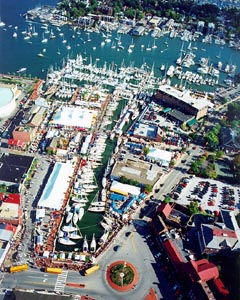
Wet-water, armchair and day-dreaming sailors are the kids to the U.S. Sailboat Show's candy shop. From October 7 through 11, you'll have full tantalizing run of the candy shop -- looking, touching, even boarding over 450 pricey 'sweets.' That's how appetites grow.
10-7 (except 6 the 7th and 11th) from Oct. 7-11 for $12 adults, $6 kids except $25 on VIP Thursday. And if sailing's not your thing, your turn comes next week when the United States Powerboat Show shows Annapolis. Spreading over permanent and floating piers brought for the show to City Dock: 410/268-8828.
| Issue 40 |
Volume VII Number 40
October 7-13, 1999
New Bay Times
| Homepage |
| Back to Archives |